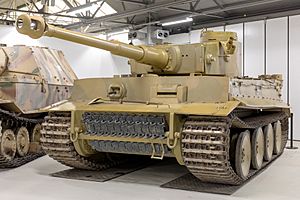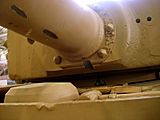Tiger 131 facts for kids

Tiger 131 on display at Tankfest 2012
|
|
| Location | The Tank Museum |
|---|---|
| Designer | Henschel & Son |
| Type | Tiger tank |
| Length | 6.316 m (20 ft 8.7 in) 8.45 m (27 ft 9 in) (gun forward) |
| Width | 3.70 m (12 ft 2 in) |
| Height | 3.0 m (9 ft 10 in) |
Tiger 131 is a famous German Tiger I heavy tank from World War II. It was captured by British forces in Tunisia. Today, it is kept at The Tank Museum in Bovington, England. It is the only Tiger I tank in the world that can still move and operate.
Contents
The Tiger Tank's Start
The Tiger 131 tank was officially known as the Panzerkampfwagen VI, Tiger I. It was built in Germany in February 1943. The main body was made by a company called Henschel, and the turret (the rotating part with the gun) was made by Wegmann AG.
The tank was sent to Tunisia in North Africa between March and April 1943. There, it joined a German heavy tank group called Schwere Panzer-Abteilung 504. It was the first tank in its platoon, which is why it got the number 131 painted on its turret. This number is how it became known.
How Tiger 131 Was Captured
For many years, people at The Tank Museum thought Tiger 131 was captured on April 21, 1943, at a place called Djebel Djaffa in Tunisia. During a battle, two Tiger tanks and other vehicles attacked. British Churchill tanks from the 48th Royal Tank Regiment fired at one Tiger.
One shot hit the Tiger's gun barrel, bouncing off and hitting the ring that lets the turret turn. This made the turret get stuck. The shot also hurt the driver and front gunner and broke the radio. Another shot hit a lifting hook on the turret, stopping the gun from moving up and down. A third shot hit a hatch, sending small pieces inside the tank. The German crew left the tank, taking their injured friends with them. The tank was damaged but could still be driven. British soldiers then took control of it.
The Real Story of Capture
In 2019, the story of how Tiger 131 was captured changed. A man named Dale Oscroft visited the museum. He noticed how similar the tank's story was to one his father, John Oscroft, had told him. John Oscroft was a British soldier who fought at a place called "Point 174" (also known as Gueriat el Atach).
On April 24, 1943, John Oscroft's unit captured Point 174. The Germans immediately counter-attacked with tanks, including Tigers. John Oscroft was told to fire his PIAT anti-tank weapon at a Tiger. He fired, but the shot bounced off. Soon after, supporting Churchill tanks arrived. One of their shots hit a Tiger, jamming its turret. This forced the German crew to leave their tank. Pictures and old documents later proved that Tiger 131 was indeed the tank captured at Point 174 on April 24, 1943.
Bringing Tiger 131 Back to Life

After it was captured, Tiger 131 was fixed using parts from other broken Tiger tanks. Experts then studied it to see how well it worked. The tank was shown in Tunis, where King George VI and Winston Churchill came to see it.
In October 1943, the tank was sent to England. It was displayed in different places to help boost people's spirits during the war. Later, it was thoroughly tested and studied by the School of Tank Technology. They wrote detailed reports about how it was built. In 1951, the tank was given to what is now The Tank Museum.

In 1990, the museum started a big project to restore Tiger 131. This involved taking almost the entire tank apart. The original engine was missing, so they put in an engine from another Tiger tank (a Tiger II) that the museum owned. They also added a modern fire safety system to the engine area. This was the only major change made to the tank. Experts also studied the engine parts to learn about the materials and how German factories made things during World War II.
In December 2003, Tiger 131 returned to the museum with a working engine. This made it the only Tiger tank in the world that could still run! It quickly became the most popular exhibit at the museum. More work was done, and the tank was repainted in its original wartime colors. The restoration was finished in 2012 and cost about £80,000.
Tiger 131 even appeared in the 2014 movie Fury. It was the first time a real Tiger tank had been used in a major film since 1950.
See also



